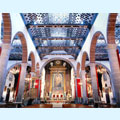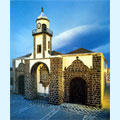ARCHITECTURE.
 There are very few references on architecture at the end of the XV century. In the XVII century there is a growth stage and in the XVIII century the cupola is the most significant element in constructions.
There are very few references on architecture at the end of the XV century. In the XVII century there is a growth stage and in the XVIII century the cupola is the most significant element in constructions.
From the middle of the XIX century up to the XX, Neostyles and eclecticism dominate the scene. Later on, at the beginning of the XX century, modernistic decorations prevail, expanding along large areas of Triana Street (calle Triana), in Las Palmas, as well as in the neighbourhood of the Hotels (Barrio de los Hoteles), in Santa Cruz de Tenerife.
 Other professionals added rationalism to the insular constructive trends of the first decades of the XX century that had a special influence on the intellectual society, while the other prevailing trend was the Neocanarian style.
Other professionals added rationalism to the insular constructive trends of the first decades of the XX century that had a special influence on the intellectual society, while the other prevailing trend was the Neocanarian style.
The islands have also gone for a vanguard architecture, where works such as the Alfredo Kraus Auditorium in Las Palmas de Gran Canaria and the Insular Auditorium- a work of Santiago Calatrava- in Santa Cruz de Tenerife stand out.
Summing up, architecture has marched according to the times and European trends.